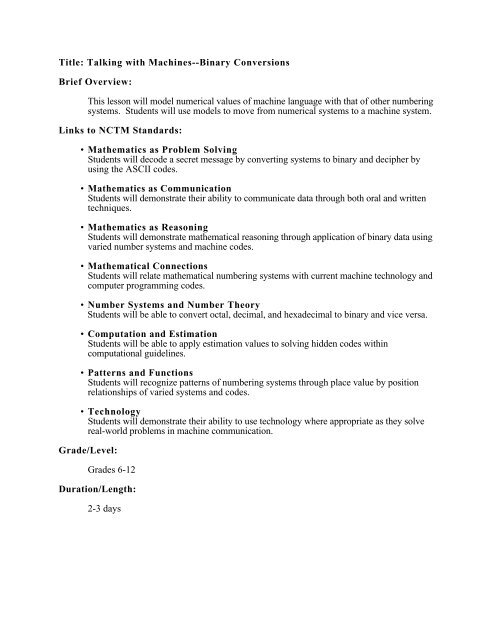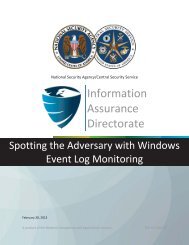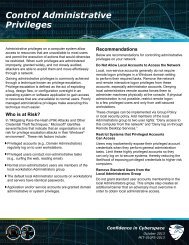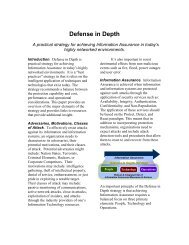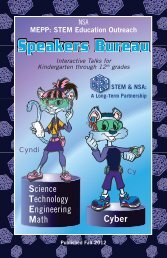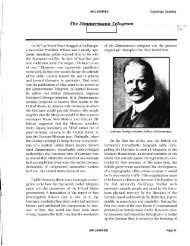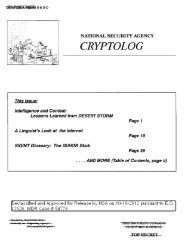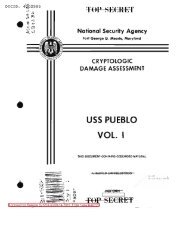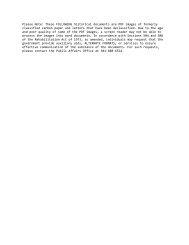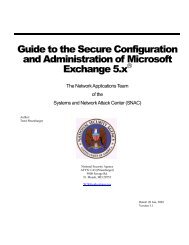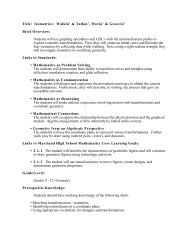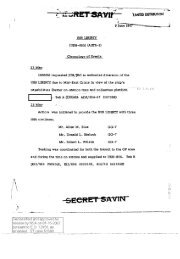Title: Talking with Machines--Binary Conversions Brief Overview ...
Title: Talking with Machines--Binary Conversions Brief Overview ...
Title: Talking with Machines--Binary Conversions Brief Overview ...
Create successful ePaper yourself
Turn your PDF publications into a flip-book with our unique Google optimized e-Paper software.
<strong>Title</strong>: <strong>Talking</strong> <strong>with</strong> <strong>Machines</strong>--<strong>Binary</strong> <strong>Conversions</strong><br />
<strong>Brief</strong> <strong>Overview</strong>:<br />
This lesson will model numerical values of machine language <strong>with</strong> that of other numbering<br />
systems. Students will use models to move from numerical systems to a machine system.<br />
Links to NCTM Standards:<br />
• Mathematics as Problem Solving<br />
Students will decode a secret message by converting systems to binary and decipher by<br />
using the ASCII codes.<br />
• Mathematics as Communication<br />
Students will demonstrate their ability to communicate data through both oral and written<br />
techniques.<br />
• Mathematics as Reasoning<br />
Students will demonstrate mathematical reasoning through application of binary data using<br />
varied number systems and machine codes.<br />
• Mathematical Connections<br />
Students will relate mathematical numbering systems <strong>with</strong> current machine technology and<br />
computer programming codes.<br />
• Number Systems and Number Theory<br />
Students will be able to convert octal, decimal, and hexadecimal to binary and vice versa.<br />
• Computation and Estimation<br />
Students will be able to apply estimation values to solving hidden codes <strong>with</strong>in<br />
computational guidelines.<br />
• Patterns and Functions<br />
Students will recognize patterns of numbering systems through place value by position<br />
relationships of varied systems and codes.<br />
• Technology<br />
Students will demonstrate their ability to use technology where appropriate as they solve<br />
real-world problems in machine communication.<br />
Grade/Level:<br />
Grades 6-12<br />
Duration/Length:<br />
2-3 days
Prerequisite Knowledge:<br />
Students should have working knowledge of the following skills:<br />
• Working in the decimal system at a pre-algebra level<br />
• Knowledge of exponents (powers)<br />
Objectives:<br />
Students will:<br />
• convert binary, octal, and hexadecimal numbers to its decimal equivalent.<br />
• convert decimal, octal, and hexadecimal numbers to its binary equivalent.<br />
Materials/Resources/Printed Materials:<br />
• Worksheets<br />
• ASCII code chart<br />
Development/Procedures:<br />
Follow the detailed lesson plan. It is broken down into sections <strong>with</strong> step by step<br />
procedures.<br />
Performance Assessment:<br />
Students should be able to do the chalkboard examples at their desk after the provided<br />
example is given on the board. Upon completion of all sections the students should be<br />
able to do the provided worksheet that converts systems to binary. The ASCII code chart<br />
can be used to find the corresponding letter to decode the secret message (Math controls the<br />
world).<br />
Extension/Follow Up:<br />
Authors:<br />
Converting from Octal to hexadecimal, <strong>Binary</strong> to Octal, etc.<br />
Truth tables<br />
Boolean Algebra<br />
Logic Gates<br />
Arithmetic in <strong>Binary</strong>, Octal, etc.<br />
Jeremy Kurutz<br />
Overlea High School<br />
Baltimore County, MD<br />
Jim Groves<br />
Overlea High Schoo<br />
Baltimore County, MD
Introductory Activity:<br />
Purpose: A motivational puzzle that demonstrates the place value of digits in the decimal<br />
number system.<br />
Find the number.<br />
1. It is a three-digit whole number.<br />
2. It is divisible by 5.<br />
3. It is an even number.<br />
4. Each of its digits is different.<br />
5. Its tens digit is greater than its ones digit.<br />
6. Its hundreds digit is greater than its tens digit.<br />
7. It is less than 400.<br />
8. It is divisible by three.<br />
9. It has only one odd digit.<br />
Answer: 210<br />
Vocabulary:<br />
Decimal number system<br />
<strong>Binary</strong> number system<br />
Octal number system<br />
Hexadecimal number system<br />
Digit<br />
Base<br />
Exponent<br />
Place value<br />
Bits<br />
Assembly language<br />
Digital integrated circuits<br />
Transistor<br />
Diode<br />
Resistor<br />
Boolean logic<br />
Switching circuits
Decimal Number System<br />
Decimal Number System -- A number system, having a base of 10. Digits are 0<br />
through 9. It is the most popular system in use. Also referred to as the Arabic number<br />
system.<br />
Place Value by Position<br />
Digit name<br />
by position Thousands Hundreds Tens Ones<br />
Exponential digit<br />
value by position 10 3 10 2 10 1 10 0<br />
We can demonstrate the value of each position(place value) by analyzing a sample decimal<br />
number.<br />
Example: 321010 = 3 x 10 3 + 2 x 10 2 + 1 x 10 1 + 0 x 10 0<br />
= 3 x 1000 + 2 x 100 + 1 x 10 + 0 x 1<br />
= 3000 + 200 + 10 + 0<br />
= 3210 10<br />
Before moving onto the binary system you may want to peak the students interest by<br />
demonstrating a math magic trick based on the binary system. It works as follows:<br />
1) Give students the worksheet full of numbers categorized in sections<br />
A through E.<br />
2) Ask them to pick a number between 1 and 30.<br />
3) Ask them to find which boxes it appears in (it could be in more than one) and<br />
give the corresponding letters.<br />
4) Use the following place value system to get a number for each letter.<br />
A - 16 B - 8 C - 4 D - 2 E - 1<br />
5) Add up the numbers and you will have their number.<br />
Example: If a student chose the number 25 it will appear in section A,B, and E<br />
16 + 8 + 1 will give the number chosen (25).
<strong>Binary</strong> Number System<br />
<strong>Binary</strong> Number System -- A number system having a base of two. <strong>Binary</strong> digits are<br />
digits 0 and 1.<br />
The binary number system is much simpler than the decimal system. It is used because it is<br />
very compatible <strong>with</strong> digital electronic circuits that are either on or off. The two binary<br />
digits of 0 and 1 are used to represent this occurrence. <strong>Binary</strong> digits are sometimes called<br />
bits, which evolved from the first and last two letters of the two words bi nary digits..<br />
Place Value by Position<br />
Digit name<br />
by position Eights Fours Twos Ones<br />
Exponential digit<br />
value by position 2 3 2 2 2 1 2 0<br />
We can demonstrate the value of each position(place value) by analyzing a sample binary<br />
number.<br />
Example: 11012 = 1 x 2 3 + 1 x 2 2 + 0 x 2 1 + 1 x 2 0<br />
= 1 x 8 + 1 x 4 + 0 x 2 + 1 x 1<br />
= 8 + 4 + 0 + 1<br />
= 13 10<br />
This example illustrates one way to convert a binary number to its equivalent decimal value.<br />
Chalkboard examples:<br />
Try converting the following binary numbers to decimal.<br />
Answers: 1410, 1510, 1010<br />
11102 11112 10102
Octal Number System<br />
Octal Number System -- A number system, having a base of 8. Digits are 0 through 7.<br />
Normally, data is fed to a computer in some system other than binary. This is because<br />
entering data in binary is time - consuming and prone to error. Also binary numbers are<br />
difficult to remember and express in words. The octal system is more closely related to<br />
binary than to decimal. Due to the large values of each digits position we will not name<br />
them below (digit name by position).<br />
Place Value by Position<br />
Exponential digit<br />
value by position 8 3 8 2 8 1 8 0<br />
We can demonstrate the value of each position(place value) by analyzing a sample decimal<br />
number.<br />
Example: 32108 = 3 x 8 3 + 2 x 8 2 + 1 x 8 1 + 0 x 8 0<br />
= 3 x 512 + 2 x 64 + 1 x 8 + 0 x 1<br />
= 1536 + 128 + 8 + 0<br />
= 1672 10<br />
This example illustrates one way to convert an octal number to its equivalent decimal value.<br />
Chalkboard Examples:<br />
Try converting the following octal numbers to decimal.<br />
Answers: 19310, 27110, 54210<br />
301 8 4178 10368
Hexadecimal Number System<br />
Hexadecimal Number System -- A number system, having a base of 16. Convenient<br />
for representing 4 bit numbers. Digits are 0 through 9 and A through F.<br />
The hexadecimal system was named from the prefix hexa which stands for six and decimal<br />
which implies ten. The first ten digits are the same as the decimal system (0-9). However,<br />
for the decimal numbers 11-15, the hexadecimal number system uses the letters A - F.<br />
Since many personal computers today use a 16-bit assembly language, the hexadecimal<br />
system has become very popular. The hexadecimal system is also more closely related to<br />
binary than decimal. Because of the large values for each digits position we will not name<br />
them below (digit name by position).<br />
Place Value by Position<br />
Exponential digit<br />
value by position 16 3 16 2 16 1 16 0<br />
We can demonstrate the value of each position(place value) by analyzing a sample decimal<br />
number.<br />
Example: 321016 = 3 x 16 3 + 2 x 16 2 + 1 x 16 1 + 0 x 16 0<br />
= 3 x 4096 + 2 x 256 + 1 x 16 + 0 x 1<br />
= 12288 + 512 + 16 + 0<br />
= 12816 10<br />
This example illustrates one way to convert a hexadecimal number to its equivalent decimal<br />
value.<br />
Chalkboard Examples:<br />
Try converting the following hexadecimal numbers to decimal.<br />
Answers: 96110, 105010, 794210<br />
3C1 16 41A16 1F0616
Converting Number Systems to <strong>Binary</strong><br />
Digital integrated circuits handle digital information using switching circuits. These simple<br />
circuits made up of diodes, transistors, and resistors can perform the basic Boolean logic<br />
functions. Boolean logic uses the binary number system. Therefore it is important to<br />
understand how to convert number systems into binary.<br />
Method: Successive division by two<br />
Example: 15310 is converted as follows.<br />
Converting Decimal to <strong>Binary</strong><br />
1) Divide the decimal number by two.<br />
2) Use the remainder from this division to fill in the ones place<br />
value.<br />
3) Continue to divide by two on each resulting quotient.<br />
4) Each remainder fills the next higher place value.<br />
5) The procedure is over when you have a division of zero.<br />
153 / 2 = 76 remainder 1 ==> 1s place<br />
76 / 2 = 38 remainder 0 ==> 2s place<br />
38 / 2 = 19 remainder 0 ==> 4s place<br />
19 / 2 = 9 remainder 1 ==> 8s place<br />
9 / 2 = 4 remainder 1 ==> 16s place<br />
4 / 2 = 2 remainder 0 ==> 32s place<br />
2 / 2 = 1 remainder 0 ==> 64s place<br />
1 / 2 = 0 remainder 1 ==> 128s place<br />
0 / 2 = 0<br />
Result: 15310 = 100110012<br />
Chalkboard Examples:<br />
Try converting the following decimal numbers to binary.<br />
12710 9310 8010<br />
Answers: 11111112, 10111012, 10100002
Converting Octal to <strong>Binary</strong><br />
Octal is more closely related to binary than is decimal. Therefore it is important to<br />
understand how to convert octal to binary.<br />
Method: 1) Convert each octal digit to its three-digit binary equivalent.<br />
2) Record it from left to right starting <strong>with</strong> the first 1.<br />
Example: 3258 ==> 3 2 5<br />
==> 011 010 101 (binary equivalent)<br />
Result: 110101012<br />
Chalkboard examples:<br />
Try converting the following octal numbers to binary.<br />
1008 4278 7028<br />
Answers: 10000002, 1000101112, 1110000102<br />
Converting Hexadecimal to <strong>Binary</strong><br />
Hexadecimal is also more closely related to binary than is decimal. Again, the relationship<br />
permits easy conversion between the systems. Therefore it is important to understand how<br />
to convert hexadecimal to binary.<br />
Method: 1) Convert each hexadecimal digit to its four-digit binary<br />
equivalent.<br />
2) Record it from left to right starting <strong>with</strong> the first 1.<br />
Example: A2516 ==> A 2 5<br />
Result: 1010001001012<br />
Chalkboard examples:<br />
==> 1010 0010 0101 (binary equivalent)<br />
Try converting the following hexadecimal numbers to binary.<br />
9F116 D0316 52C16<br />
Answers: 1001111100012, 1101000000112, 101001011002
At this time the students should complete the worksheet entitled Converting to <strong>Binary</strong>.<br />
After numbers in decimal, octal, and hexadecimal are converted to binary the ASCII code<br />
chart can be used to find the corresponding letter. The secret message will read: Math<br />
controls the world. For example:<br />
7710 will be converted to 10011012 which corresponds to the letter M<br />
on the ASCII code chart.


